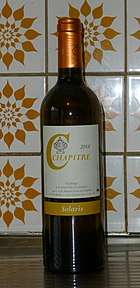Solaris (grape)
Solaris is a variety of grape used for white wine. It was created in 1975 at the grape breeding institute in Freiburg, Germany by Norbert Becker.[1]
| Solaris | |
|---|---|
| Grape (Vitis) | |
 Solaris grapes harvested in Lysekil, Sweden | |
| Color of berry skin | Blanc |
| Species | Vitis hybrid |
| Also called | 240-75 |
| Origin | Freiburg, Germany |
| Original pedigree | Merzling x GM 6493 |
| Pedigree parent 1 | Merzling = Seyve-villard 5276 x (Riesling x Pinot gris) |
| Pedigree parent 2 | GM 6493 = Zarya Severa x Muscat Ottonel |
| Notable regions | Germany |
| VIVC number | 20340 |
Pedigree
Becker created Solaris by crossing the variety Merzling (which is Seyve-villard 5276 x (Riesling x Pinot gris)) as mother vine with Gm 6493 (which is Zarya Severa x Muscat Ottonel) as the father vine.[2] Gm 6493 was one of several crossings created in Czechoslovakia in 1964 by Professor Vilém Kraus. Kraus offered several of his crosses to Dr. Helmut Becker at the Geisenheim grape breeding institute, where additional work was carried out, and where his plants were given "Gm" serial numbers for Geisenheim. Gm 6493 has previously been erroneously stated to be Saperawi Severni x Muscat Ottonel but is now identified as Zarya Severa x Muscat Ottonel.[3]
Solaris is stated as a Vitis vinifera grape, although it contains traces of hybrid grapes in its pedigree. It is an approved as a Vitis vinifera grape by EU, to grow and make wine of. It is formally listed as a Vitis vinifera cultivar.[2] It received varietal protection in 2001.
Solaris was the product of a programme for breeding disease-resistant grape varieties, and has good resistance against fungal attacks. As it is a hardy variety, it is commonly grown in northern European countries with marginal climate for winemaking, such as Belgium, the Netherlands, England, Denmark and Sweden. As of 2007, there were 54 hectares (130 acres) of Solaris in Germany, of which 35 hectares (86 acres) were in Baden, where Freiburg is located.[4]

Properties
Solaris is an early ripening variety with good resistance against fungal diseases and frost.[4] It gives wines which have fruity and perfumed aromas with hints of banana and hazelnuts, with medium acidity. It is considered to be suitable for dessert wines, as it ripens to high must weights. In cooler climate, with less sugar content, also as a dry wine suitable for fish, shrimps or chicken.[1]
Here are some service ideas for Solaris
- As an Aperitif; serve chilled, not cold.
- As a Cocktail mixer; with apple or pineapple juice, club soda or tonic water, add a twist and a sprig of mint.
- With Appetizers in a cordial glass.
- With Cheese; Northern Lights Blue, Roth Kase Gran Queso.
- With dessert; fruit tarts in a buttery pastry.
- For dessert; serve at room temp; then linger at the table with your guests.
Refrigerate after opening; warm slightly before serving.
References
- Winegrowers.info: Vine variety: Solaris, accessed on March 25, 2008
- Vitis International Variety Catalogue: Solaris Archived 2012-04-05 at the Wayback Machine, accessed on March 25, 2009
- Vitis International Variety Catalogue: Geisenheim 6493 Archived 2012-04-05 at the Wayback Machine, accessed on March 26, 2009
- Wein-Plus: Solaris, accessed on March 6, 2013